Hunting for Ogres: Akita’s Namahage
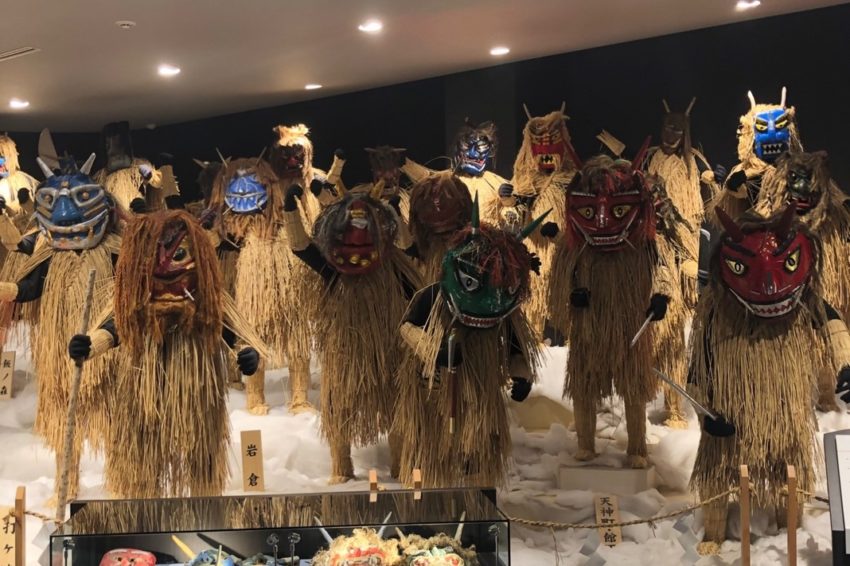
Do you want to experience more of traditional Japanese culture, but tea ceremonies and 4-hour plays aren’t your thing? Then look no further than Akita in the Tohoku region of north Honshu. It’s one of Japan’s most distinctive and quirky prefectures. Akita has a strong sense of identity, and plenty to offer the curious visitor.
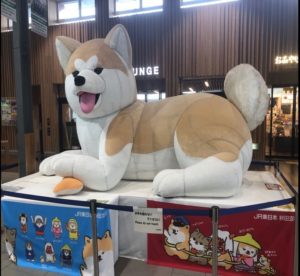
An Akita dog on proud display
Akita is of course the origin of the beloved and iconic Akita dog (Akita inu or 秋田犬). It is also often said to be home to the most attractive women in the whole country, as posters around Akita City will proudly proclaim.
But beating out both of these appeal points as the face of Akita’s identity is….. ogres traumatizing children. Specifically, ogres known as “Namahage”.
If, like me, you find it extremely fascinating to see what the monsters of another culture’s folklore look like, then there is no better place to be than right here in North Western Tohoku. Let’s take a look at what Namahage are, just how prevalent they are in Akita, and how you too can experience this unique piece of Japanese culture.
A Prefectural Icon
Namahage have unquestionably become the mascot and defining icon of Akita prefecture. They are likely to be used as Akita’s representative in any kind of illustrated map or other cartoon representation of Japan’s prefectures. This is something the people and local government lean into heavily.
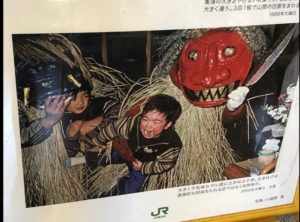
One of many Namahage posters decorating Akita station
For most visitors to the prefecture, your journey begins with arrival at Akita Station. You will immediately be greeted by posters of these ogres snatching away hysterically bawling children. These have been proudly pasted all over the walls of the station and help set the mood.
Going deeper in, and you will see various giant replicas of the Namahage masks on display, giving Akita station a certain character to it unlike any other. Within the souvenir shops you would expect from a city’s main station, the various cookies, pies, and other snacks feature Namahage on their packaging.
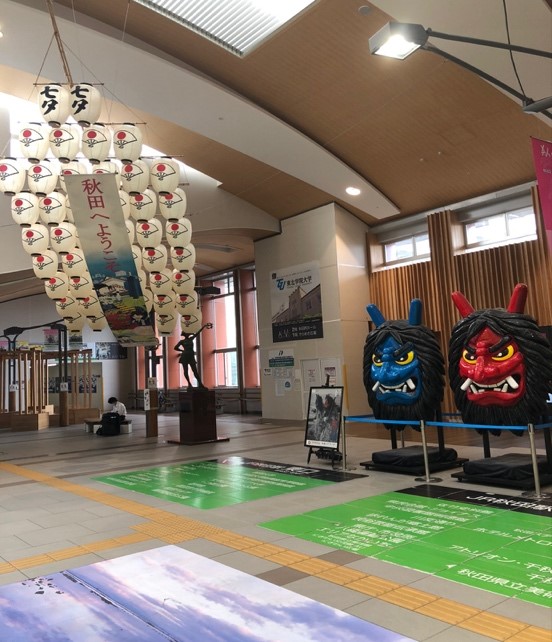
View from Akita station main gate
Venturing out into Akita city, paintings and sculptures of Namahage commonly decorate various shops and restaurants. Locals drink Namahage-branded alcohol commonly available at local convenience stores.
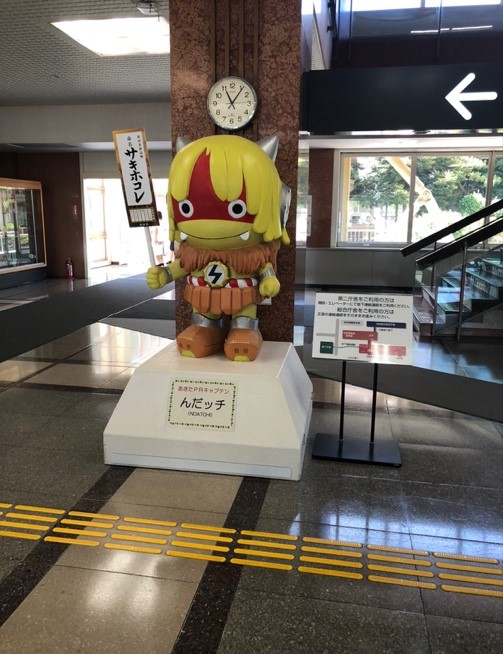
Namahage at city hall
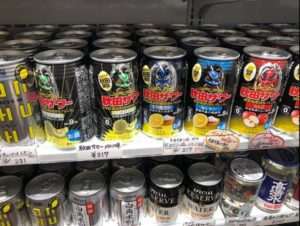
Namahage drinks at a local grocery store
It cannot be overstated how inescapable these monsters are. Already it’s clear that this isn’t some obscure gimmick or seasonally limited thing. This is an everyday part of life in the prefecture.
Our hunt for monsters is already off to a great start.
Namahage Explained
But just what is a Namahage? Where do they come from? And why do parents let this happen to their children? Understanding of what a Namahage is varies by legend.
They are best known here in Akita prefecture, but much less well-known versions of the tradition do exist in isolated pockets of such areas as Iwate, Ishikawa, and Fukui. They are most commonly interpreted as ogres or wild mountain spirits. Variant legends claim they are shipwrecked warriors from the attempted Mongolian invasions of ancient past. Another story holds that a Chinese emperor brought them to the region. Whatever the case, they are characterized by their ogre masks, straw cloaks, and oversized prop knives.
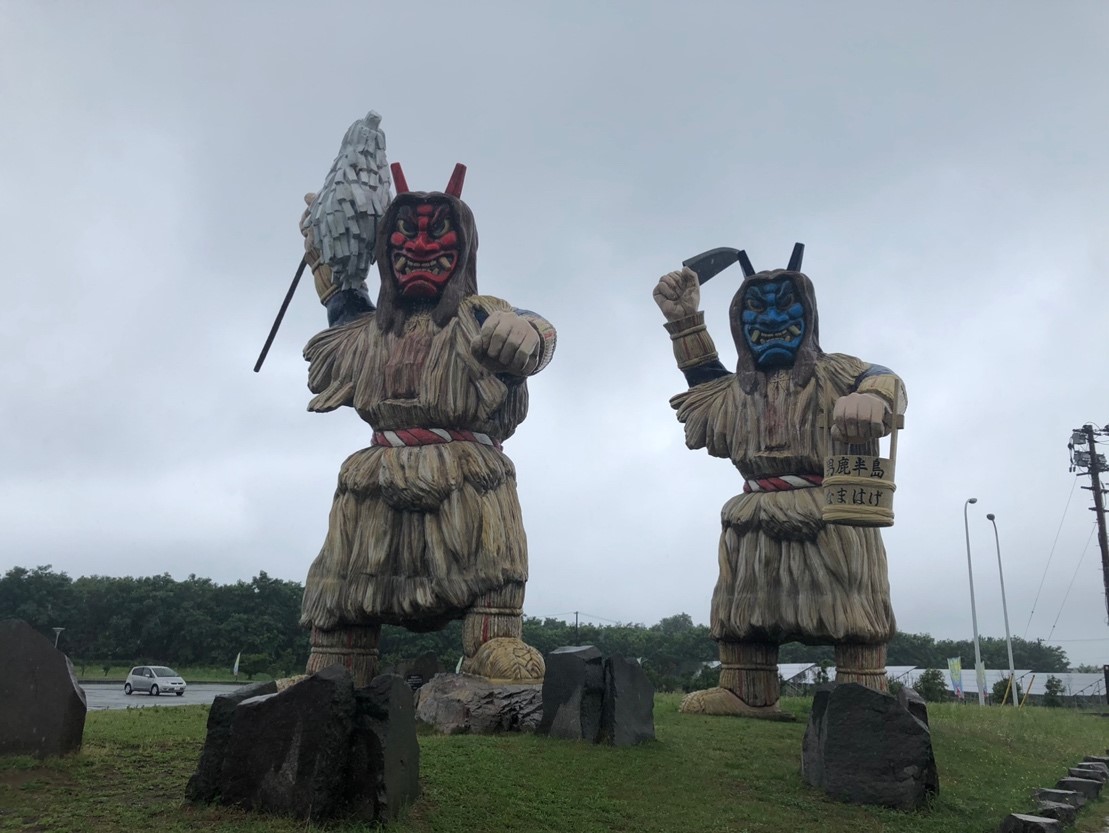
Giant Namahage outside of a tourist center
While adopted as the icon of the whole prefecture, they originate in a small town called Oga located slightly North of Akita City. They travel in pairs, visiting homes on either New Year or the Japanese “Little New Year”, where they scold and intimidate children to stop being lazy or disobedient. In fact, the name “Namahage” implies they are going to use their knives to forcefully scrape off the heat blisters one would get on one’s feet from lazing around by the fireplace all day instead of being productive.
Parents will make requests in advance to the Namahage actors for them to make a home visit, often providing them specifics on what behavioral issues they want the Namahage to bring up when they’re scolding the children. Once the kids have been frightened into swearing to change their ways, the Namahage leaves, often having been bribed into accepting mochi in place of taking the child.
Where to Find These Ogres
What’s that I hear you say? I want to see this for myself, but I won’t be able to go on New Year’s specifically, and I don’t live in Oga village with small children. What am I to do?
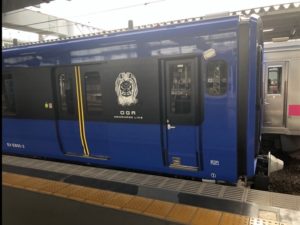
The Namahage line train
Never fear, as Oga has got you covered. Having come this far, a few displays and branded food packages won’t be enough to satisfy your folklore craze. From Akita Station, it’s around a 40-minute train ride on the appropriately named Namahage line to Oga station.
As you ride the train, look carefully out the windows, and on a clear day, you may just see the giant Namahage statues of the visitor center menacing over local traffic. Definitely worth a stop and a photo op on the way back.
Arriving at Oga, you’ll see they’ve gone all-in with this tradition, with a pair of Namahage lurking in the station waiting room and various other related decorations scattered about.
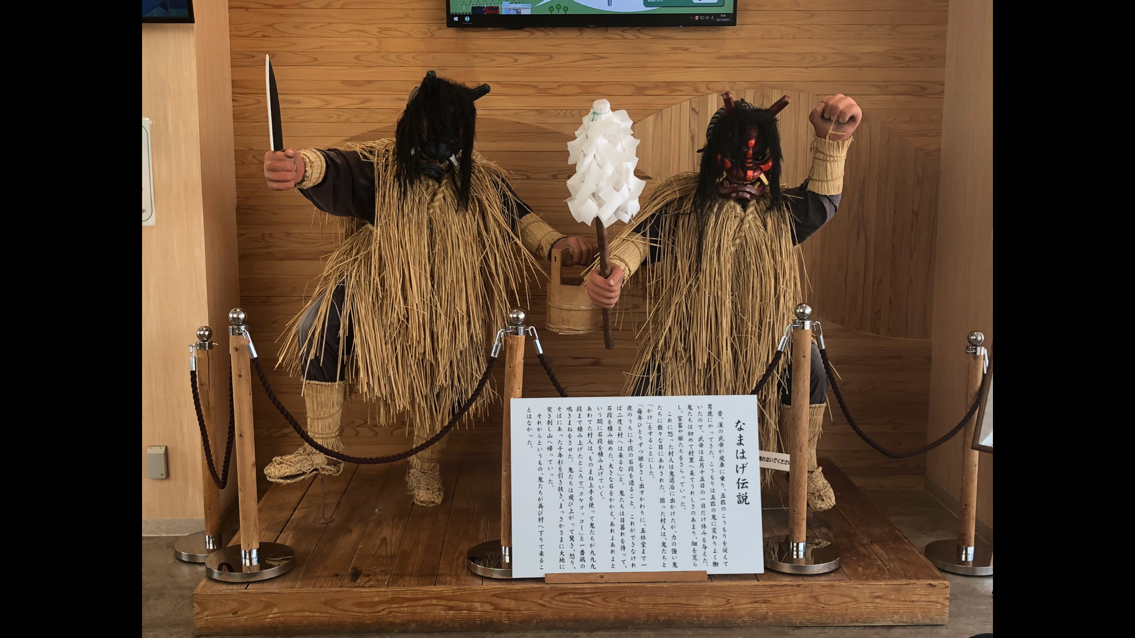
Display at Oga station
From Oga station, take a short bus ride to the Shinzan shrine, the home of the Namahage. It’s a shrine that, like Akita, has a lot of personality. It is here that the Namahage begin their rampage on New Year’s. Walk 2 minutes down the hill to the Namahage museum, where we reach the climax of our journey.
Here you can see plenty of information on the Namahage. There’s also theater showing videos of the monsters in action, collections of masks both from Akita, and a display for similar monster traditions in such countries as Hungary and Indonesia. Best of all, a hall filled with dozens of Namahage.
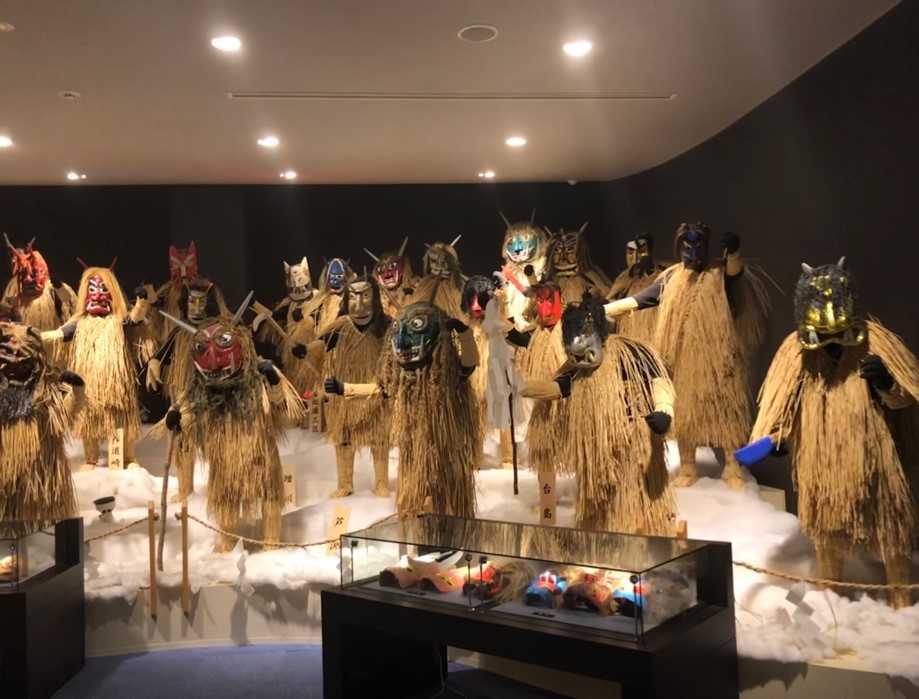
Inside the Namahage museum
Each small town or sub-district is purported to have their own variant in mask style, and you can see them all on display here. Finally, head next door, to where they hold Namahage shows hourly. Sit on the tatami mat of the traditional wooden house and get the full experience for yourself. Cower as two Namahage beat down the door and burst inside.
Japanese tourists often bring their own babies and toddlers to this show, so there will most likely be some crying in the audience for a truly authentic experience. From there, actors entertain the Namahage with food and drink as they pull out their naughty list and consult on who they’ve seen being up to no good in the village. It’s truly an experience like no other.
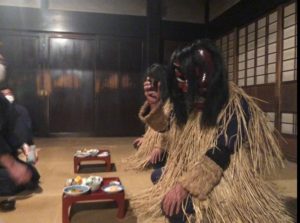
Namahage show
I cannot recommend Akita enough. There’s excellent food, nature, and more “conventional” festivals here as well to balance out your trip. But it’s this exciting, wild, and scary tradition that truly puts the prefecture above its competition.
If folklore and monsters get you excited, you won’t find anywhere better in the whole country. Akita is easily reached via Shinkansen or night bus from major hubs like Tokyo or Sendai. When next having free time and an adventurous spirit, give the place a try for an experience you will never forget!
Photo & Information Credits:
All photos are original and taken by me (Jacob Newcomb) on location.
Information used came from displays at the Namahage museum, as well as the Wikipedia article on Namahage and “A study of Appossha”, by Hiroko Shiose, a Japanese language academic research paper which I personally translated into English as a final term project in my studies at the University of Florida.
https://www.gsid.nagoya-u.ac.jp/bpub/research/public/forum/48/02.pdf
All other content (text) created by the original author and © 2022 MUSUBI by Borderlink
RELATED
-
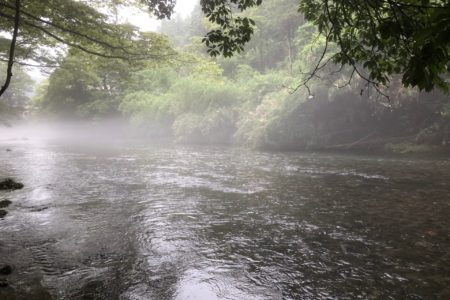
At a Glance: The Beauty of Bonomine
Top photo: provided by MUSUBI staff member, used with permission Bonomine is one of the hidden gems Japan is f… -
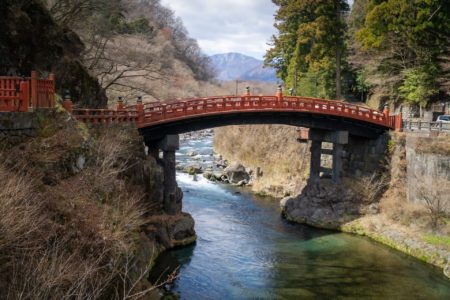
A Cheeky Peek at Tochigi
A stone’s throw away from Tokyo, Tochigi prefecture (栃木県) offers a range of beautiful imagery, fr… -
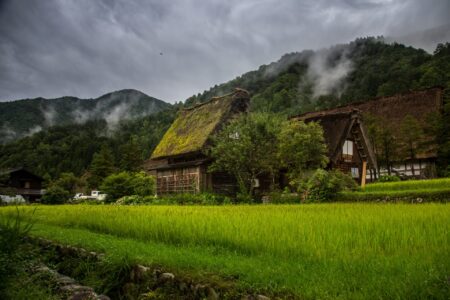
For Vacations, Smaller (Not Less) Is More
Top photo: Photo by Luke Paris on Unsplash Vacation travel in Japan is quite different from that in the US. O…
PEOPLE

Jacob Newcomb
From Tampa, Florida, United States
Has experienced Japan for 2 years so far, has been learning the language and culture for 10!


